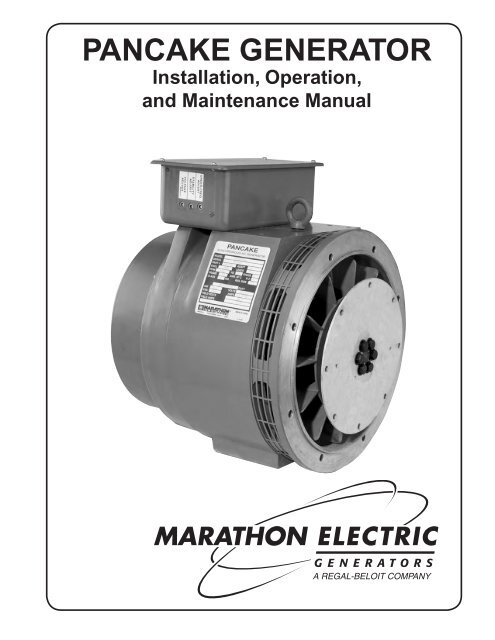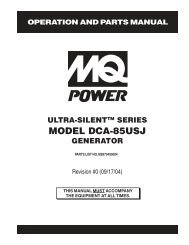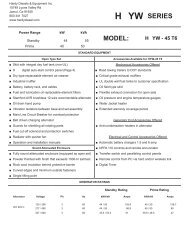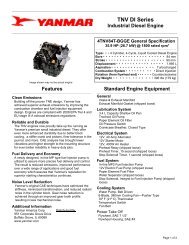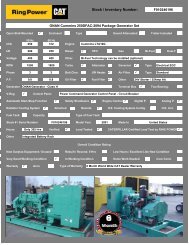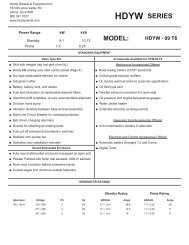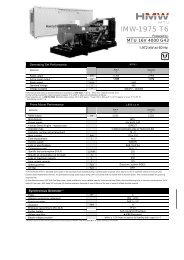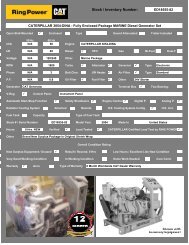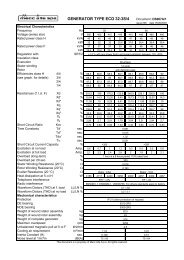You also want an ePaper? Increase the reach of your titles
YUMPU automatically turns print PDFs into web optimized ePapers that Google loves.
n. Remount exhaust screen band.o. To reassemble the armature, pull main rotor leadsthrough the holes in the exciter rotor.DO NOT PINCH ROTOR LEADS.p. Replace the mounting bolt, lock washer, andBelleville washer. Using a 9/16” socket on a torquewrench, torque the mounting bolt to 30 to 35 ft-lb.q. Reconnect main rotor leads to proper connections.r. Reconnect all incoming power leads as shown onwiring diagram.s. Replace pot cover or control box cover.t. Remove jack support from under engine flywheelhousing.u. See preceding paragraph “a.” If necessary,reconnect positive (+) lead to the engine crankingbattery.ELECTRICAL CONNECTIONSNOTE: INSURE THAT ALL ELECTRICAL CONNECTIONS ARE CORRECT BEFORE STARTING <strong>GENERATOR</strong>.REFER TO THE AUTOMATIC VOLTAGE REGULATOR (AVR) MANUAL FOR SPECIFIC INSTRUCTIONS FORCONNECTING THE AVR.Dedicated 4 lead single phase generator connections.SINGLE PHASE CONNECTION - DUAL VOLTAGE SERIESVOLTAGEL-LL-N60 HZ 240 12050 HZ 220 110SINGLE PHASE CONNECTION - SINGLE VOLTAGE PARALLELVOLTAGEL-L60 HZ 12050 HZ 1104
Three phase, 12 lead generator connections.Note: 12 lead Pancake generators are not broad range voltage machines. The voltages available in a given threephase connection are model specific. Refer to the generator nameplate, or the factory, with the generator modelnumber, for the voltage available from your unit in any of the below listed connections.DOUBLE DELTA–SINGLE PHASE CONNECTIONVOLTAGEL-LL-N60 HZ 240 120LOW ZIG ZAG–SINGLE PHASE CONNECTIONVOLTAGEL-LL-N60 HZ 240 12012 LEAD HIGH VOLTAGE (SERIES) WYE (STAR) CONNECTIONVOLTAGEL-LL-N60 HZ4804604404162772662542405
12 LEAD HIGH VOLTAGE (PARALLEL) WYE (STAR) CONNECTIONVOLTAGEL-LL-N60 HZ24023022020813912012712012 LEAD HIGH VOLTAGE (SERIES) DELTA CONNECTIONVOLTAGEL-LL-N60 HZ 240 12012 LEAD HIGH VOLTAGE (PARALLEL) DELTA CONNECTIONVOLTAGEL-LL-N60 HZ 120 N.A.6
OPERATIONInitial Pre-Start InspectionBefore starting the unit for the first time, the followinginspections and checks are recommended:a. Clear the site area of any loose parts, connections,or foreign materials such as cut off tie wrap ends,scrap insulating tape, tools, hardware, etc.b. Insure that the set turns freely. Bar the set over byhand for at least 2 revolutions to be sure that thereis no interference. Do not use the generator’s fan asa fulcrum to bar over the set. If the generator rotorseems to bind, check for clearance in the generatorand exciter air gap.c. Check all wiring against the proper connectiondiagrams, and insure that all connections andterminations are tight and properly insulated.<strong>PANCAKE</strong> <strong>GENERATOR</strong>S MAY HAVE VOLTAGEPRESENT AT THEIR LEAD TERMINALS WHEN THESHAFT IS ROTATING. DO NOT PERMIT OPERATIONOF THE UNIT UNTIL ALL LEADS HAVE BEENCONNECTED AND INSULATED. FAILURE TO DO THISMAY RESULT IN PERSONAL INJURY OR EQUIPMENTDAMAGE.d. Insure that all equipment is properly grounded(earthed).e. Inspect for any remaining packing materials, andremove any loose debris, building materials, rags,etc., which could be drawn into the generator.f. Check all fasteners for tightness.g. Check all access plates, covers, screens, andguards. If they have been removed for assembly orinspection, reinstall and check for security.h. Review all prime mover manufacturer’s pre start‐upinstructions, and insure that all recommended stepsand procedures have been followed.i. Remove any paint masking material from thegenerator nameplate and warning/caution decals.Initial Start-UpThe following procedure should be followed for starting‐upthe generator set for the first time:a. The generator output must be disconnected from theload. Be sure that the main circuit breaker or fuseddisconnect is in the open position.b. Open the input power to the automatic voltageregulator (AVR). Remove the fuse or disconnect andinsulate one of the AVR input power leads (see AVRmanual).c. Insure that all prime mover manufacturer’spre‐start-up and start‐up procedures have beenfollowed.d. Start the prime mover, and adjust it for properspeed (frequency). (See generator nameplate.)e. The purpose of this initial test with the AVR outof the circuit is to detect any wiring mistakeswithout exposing the unit to undue risk. Checkall Line‐to‐Line and Line‐to‐Neutral voltages forbalanced voltage. At this point, with the AVRde‐energized, the residual voltage should beabout 10% to 25% of rated value. If voltages areunbalanced, shut down the equipment and check forimproper wiring. Re‐start the set, and again checkfor voltage balance. If the problem persists, consultthe factory. If everything checks good, shut downthe set and reconnect the AVR. It is recommendedthat the residual voltage, together with driver rpm,be recorded for use as a future troubleshootingbenchmark.f. Start the set and adjust the terminal voltage tothe desired value by means of the AVR voltageadjustment device. If the AVR is equipped with astability adjust, follow the instructions in the AVRmanual to adjust the stability. Again, check allline‐to‐line and line‐to‐neutral voltages for balance.It is recommended practice to record the no loadexcitation (DC voltage across F+ and F‐) togetherwith line‐to‐line voltage and driver rpm as a benchmark for future troubleshooting.THIS PROCEDURE MUST BE CONDUCTED BYQUALIFIED ELECTRICAL PERSONNEL. LETHALVOLTAGE MAY WELL BE PRESENT AT BOTH. THE<strong>GENERATOR</strong> AND VOLTAGE REGULATOR TERMINALSDURING THIS PROCEDURE. CAUTION MUSTBE EXERCISED NOT TO COME INTO PERSONALCONTACT WITH LIVE TERMINALS, LINKS, OR STUDS.SERIOUS INJURY OR DEATH COULD RESULT.g. Close the main circuit breaker to the load. If the unitis equipped with space heaters, insure that they areturned off.h. Monitor the generator output current to verify that itis at or below nameplate value.7
i. Check generator frequency (speed) under load.Adjust as necessary. (Refer to prime mover/governormanuals)Shut down procedures.There are no specific instructions for shut down of thegenerator; however, several good engineering practicesshould be observed to prolong equipment life.a. It is advisable to disconnect all loads (open maincircuit breaker or disconnect) prior to shut down.This is especially important if loads can be damagedby low voltage and/or frequency conditions duringgenerator “coast down”.b. Isolate any condition that could allow the generatorto see a voltage at its terminals while at rest.Failure to do this could result in personnel injury orequipment damage.MAINTENANCERoutine MaintenanceYour <strong>Marathon</strong> Pancake generator has been designed tobe as reliable and trouble free as is possible. However,costly repairs and down time can be minimized byoperating the unit under conditions that are compatiblewith those at which the equipment was designed tooperate (See OPERATION section). The followingmaintenance procedures should be followed to insurelong equipment life and satisfactory performance.a. Routinely check intake and exhaust air screensto insure that they are clean and free of debris.Clogged intake air screens will reduce coolingairflow and may result in the unit operating atdangerously high temperatures which reduce thegenerator’s life. This inspection and cleaning shouldbe done in conjunction with prime mover air filtercleaning and/or change‐out.b. Periodically (approximately every one thousand[1000] operating hours) check the bearing(s).Pancake generators are equipped withprelubricated‐for‐life bearings which do not requireroutine lubrication.c. Periodically inspect the unit for buildup ofcontamination (dirt, oil, etc.) on the windings. Ifthe wound components have become coated withheavy concentrations of oil and grime, the unitshould be disassembled and thoroughly cleaned.This operation is not one that can be accomplishedeffectively on site, but rather one that should beconducted by an authorized service center equippedwith the appropriate apparatus and solventsnecessary to properly clean and dry the generator.d. Periodically, about once every 2000 operatinghours, or in conjunction with scheduled enginemaintenance, check the DC no load excitationvoltage. Compare this voltage with the valuerecorded during initial startup. If this value of noload excitation voltage is markedly higher than thebenchmark reading, it is an indication of problemsin either the exciter field, main field, or possibly therotating rectifier assembly. Insure that voltage andrpm is the same as initial test conditionDrying Generator WindingsGenerators in service may inadvertently have theirwindings exposed to splashing or sprayed water. Unitsthat have been in transit or storage for long periods oftime may be subjected to extreme temperature andmoisture changes causing excessive condensation.Regardless of the source of moisture, wet windingsshould be thoroughly dried out before operating the unit.If this precaution is not taken, serious damage to thegenerator can result. The following procedures may beused to effectively dry the unit’s windings:a. <strong>Electric</strong> space heaters can be installed inside thegenerator frame. When energized from a powersource other than the generator itself, they will heatand dry the inside of the generator. If an alternatesource of electricity is not available, enclose the unitwith a covering, and insert heating units to raisethe machine’s temperature 15°F to 18°F (8°C to10°C) above the outside temperature. Leave a holeat the top of the enclosure to permit the escape ofmoisture.b. If the windings are damp, but not saturated, run theset for approximately 1 to 2 hours with excitationoff (AVR power supply open). If the windings havebeen saturated, a portable air heater can be usedby directing heat into the air intake openings, andrunning the set with no load and the excitation offfor several hours. Heat at point of entry should notexceed 150°F (66°C).SERVICEGeneralThe service procedures given in this section arethose which can reasonably be conducted on-sitewith a minimum of special tools and equipment. Allservice procedures should be conducted by qualifiedmaintenance personnel.8
Restoring Residual Magnetism (Flashing the ExciterField)To restore the small amount of residual magnetismnecessary to begin voltage buildup, connect a 12‐voltbattery to the exciter field while the generator set is atrest as follows:a. Remove exciter field leads F+ and F‐ from the AVR.Failure to remove the exciter field leads fromthe automatic voltage regulator during flashingprocedures may destroy the regulator.b. Connect exciter field lead F+ to the positive poleof the battery. Holding the F‐ lead by the insulatedportion of the lead wire, touch exciter field leadF‐ to the negative pole of the battery for about 3 to5 seconds. Remove the lead . You should see aninductive arc. If no arc is drawn when removing theF‐ lead, repeat the procedure.c. Reconnect F+ and F‐ to the AVR, re‐start the unit,and observe voltage build‐up. Repeat the procedureif build‐up fails to develop.WHITE LEADS FROM EXCITER ROTOR TOCONNECT TO RECTIFIER MTG PLATE ASYHAVING THE "RED" MARKED SCREW ENDthe diodes contains three “Reverse” stud type diodes.The diodes may be tested in the field without removingthem from the heat sinks. <strong>Electric</strong>ally isolate the individualdiodes by removing each of exciter rotor lead flagterminals from the quick connect diode terminals, andremove the two main rotor leads from the main rotorterminal posts. Test each sub-assembly separately. Anohmmeter or a battery light continuity tester may be usedto find an open or shorted condition in the diode. Placeone tester probe on the main post. In succession, touchthe other test probe to each diode terminal. Reverse theprobes and repeat the procedure. You have now testedthe three diodes on this sub-assembly. Repeat the test onthe second sub-assembly. These tests should indicateone of three conditions:a. Good diode: Will have a much greater resistancein one direction than the other. Typical reverseresistance will be 30,000 ‐ 300,000 ohms or greater,while typical forward resistance will be less than 10ohms. The battery‐light tester will have the light “on”in one direction, and “off” in the other.b. Shorted condition: Ohmmeter reading will be zero orvery low in both directions. The continuitytester will have the light “on” in bothdirections.(RED) SCREW ENDREF. LEAD No.c. Open condition: Ohmmeter will havea maximum (infinity) reading in bothdirections. Continuity tester light will bedark (off) in both directions.BLACK LEADS FROM EXCITER ROTOR TOCONNECT TO RECTIFIER MTG PLATE ASYHAVING THE "BLACK" MARKED SCREW ENDFigure 2 - Rotating Rectifier Assembly(BLACK) SCREW ENDDiode failure after approximately a 25hour “run‐in” period is generally traceableto external causes such as lightningstrike, over heating, reverse current fedinto the unit, line voltage spikes, etc..All 6 diodes are essentially in the samecircuit. When one or more diodes havebeen stressed to failure, there is no easymethod to determine how badly stressedthe remaining diodes may have been.Therefore, to avoid possible continuedfailures and increased down time, it isrecommended practice to replace theentire assembly rather than to replaceonly the individual failed diodes. If therectifier assembly is to be repaired, theassembly must be removed from the unit.Testing the Rotating Rectifier AssemblyThe complete assembly consists of two semi-circularsub-assemblies (see Figure 2). The half assembly havingwhite leads on the diodes contains three “Forward” studtype diodes, and the half assembly having black leads on9
SPARE PARTSAlways include the name of the part, the quantity of each part ordered, and the serial and model numbers from thegenerator nameplate when ordering parts. For ordering information, contact:<strong>Marathon</strong> <strong>Electric</strong> Manufacturing Corporation100 E. Randolph StP.O. Box 8003Wausau, WI 54402‐8003Phone: 715.675.8257 (or) 800.477.6362, ext. 8257RETURNED GOODSConsult <strong>Marathon</strong> <strong>Electric</strong> Manufacturing Corporation at the address above for authorization prior to returning anyproduct. We cannot be responsible for any items returned without authorization.Single bearing generators must have their rotor assembly properly secured to prevent damage during transit tothe factory or to an authorized service center.TROUBLESHOOTING PROCEDURESGeneralThis section is intended to suggest a systematic approach to locating and correcting generator malfunctions. Thesection is arranged according to the symptoms of the problem. The steps have been arranged in an attempt to (1);dothe easy checks first, and (2); prevent further damage when troubleshooting a disabled machine.HIGH VOLTAGES MAY BE PRESENT AT THE <strong>GENERATOR</strong> TERMINALS WHEN THE UNIT IS RUNNING. TOOLS,CLOTHING, AND YOUR BODY MUST BE KEPT CLEAR OF ROTATING PARTS AND ELECTRICAL CONNECTION.SPECIAL PRECAUTION MUST BE TAKEN DURING TROUBLESHOOTING SINCE PROTECTIVE COVERS ANDSAFETY DEVICES MAY BE REMOVED OR DISABLED TO GAIN ACCESS AND MAKE TESTS. BE CAREFUL.SERIOUS PERSONAL INJURY OR DEATH CAN RESULT FROM THESE HAZARDS! CONSULT QUALIFIEDPERSONNEL WITH ANY QUESTIONS.Speed DeviationsThe generator speed should be maintained at rated nameplate value during all operating tests. The frequency of thegenerator depends upon rotative speed. Most AVRs used with our Pancake generators have built in underfrequencyprotection such that if the speed is reduced more than 5%, the voltage will drop off rather rapidly with further reductionsin speed (see AVR Manual).SYMPTOM: <strong>GENERATOR</strong> PRODUCES NO VOLTAGE, OR RESIDUAL VOLTAGEAVR fuse blown.Voltmeter Off.Defective voltmeter.AVR is not getting power.Loss of residual magnetism.CAUSECHECK AND REMEDYCheck fuse with ohmmeter. Replace if bad. Refer to AVRmanual.Check meter selector switch to insure it is not in the Offposition.Check voltage with separate meter at the generator terminals.Measure voltage at input. If no voltage, check for inputline‐to‐line residual voltage.Flash the field. See “Restoring Residual Magnetism” onpage 9 of the SERVICE section.10
AVR protective circuit is operating.AVR inoperative.Open in stator windings.Defective diodes.Broken or shorted exciter or main rotor leads.Defective exciter windings.Consult AVR manual.Adjust or replace AVR. Refer to AVR manual.Check for continuity in the windings. Return to factory ortake to service shop if open.Check rectifier assembly (page 9). Replace if defective.Test and repair or replace.Inspect for damaged or burned exciter or main rotor.Check resistance with Kelvin bridge. Megger for short tocore. Return to factory or take to service shop to effectrepairs.SYMPTOM: <strong>GENERATOR</strong> PRODUCES LOW VOLTAGE, NO LOADCAUSECHECK AND REMEDYFaulty metering.Check voltage with separate meter at generator terminals.Low Speed.Check driver for proper speed. Adjust as necessary. Checksheave ratio if belt driven.Incorrect generator lead connections.Verify generator connection. See drawings supplied withthe unit or appropriate connection diagram in this manual.Defective connections.AVR adjustments.Faulty diodes.Faulty main rotor.Inspect all wiring for grounds, open circuits, short circuits,or loose/dirty connections.Adjust AVR per AVR manual. Check exciter field voltage.Check rectifier assembly (page 9). Replace if defective.Check main rotor pole windings. If winding appears tobulge mid‐way down body of pole, refer to service shop, orreturn to factory for service.SYMPTOM: <strong>GENERATOR</strong> PRODUCES LOW VOLTAGE WHEN LOAD APPLIEDCAUSECHECK AND REMEDYDriver speed droop, or belt slip.Check driver. If belt driven, check belt tension. Check “cornerfrequency” on AVR. Under frequency voltage roll-offmay be activated.Excessive load.Reduce load. The load on each leg should be as evenlybalanced as possible, and it should not exceed rated currenton any leg.Line voltage drop.If voltage is proper at generator terminals, but low at loadterminals, increase external lead size. This is especiallytrue if external leads are long.Low load power factor.Reduce lagging power factor load. Some AC motors drawapproximately the same current regardless of load. Do notuse motors of larger capacity than is necessary to carrythe load.11
SYMPTOM: <strong>GENERATOR</strong> PRODUCES FLUCTUATING VOLTAGE (May be indicated by light flicker)Irregular engine speed.AVR stability.CAUSELoose terminal or load connections.Defective bearing causing uneven air gap.CHECK AND REMEDYCheck engine for malfunction, or load for fluctuationAdjust AVR stability. Refer to AVR manual.Make better connection both mechanically and electrically.Replace worn bearing. Check bearing bore in the bearingbracket for wear. Replace as necessary.SYMPTOM: <strong>GENERATOR</strong> PRODUCES HIGH VOLTAGECAUSECHECK AND REMEDYFaulty metering.Check voltage with separate meter at generator terminals.Excessive speed.Check engine for malfunction. If belt driven, check sheaveratio.Incorrect connections.Verify generator connections. Refer to drawings suppliedwith unit or with drawings in this manual.Incorrect AVR sensing.Consult AVR manual.AVR adjustments.Adjust AVR (consult AVR manual).Defective AVR.Replace AVR.SYMPTOM: <strong>GENERATOR</strong> IS OVERHEATINGCAUSEGenerator is overloaded.Clogged ventilating screens.High ambient temperature or altitude.Insufficient circulation of cooling air.Dry bearing.CHECK AND REMEDYReduce load. Check with ammeter and compare withnameplate rating.Clean air passages.Improve ventilation, or reduce load.Provide cross‐ventilation.Replace bearing.SYMPTOM: <strong>GENERATOR</strong> PRODUCES MECHANICAL NOISECAUSECHECK AND REMEDYDefective bearing.Replace bearing.Loose or misaligned coupling.Tighten or realign.Belt slap or loose guards.Check belt tensioning. Check belt guard fasteners.SYMPTOM: <strong>GENERATOR</strong> PRODUCES SHOCK WHEN TOUCHEDCAUSECHECK AND REMEDYStatic charge.Ground generator frame.Grounded armature or field coil.Take to service shop or return to factory for repair.12
IMPORTANT INFORMATIONPlease Read CarefullyThis document is not intended to provide operational instructions. Appropriate <strong>Marathon</strong> <strong>Electric</strong> instructions provided with thegenerator and precautions attached to the generator should be read carefully prior to installation, operations and/or maintenance of theequipment. Injury to personnel or generator failure may be caused by improper installation, maintenance or operation.The following and information is supplied for your protection and to provide you with many years oftrouble free and safe operation of your <strong>Marathon</strong> <strong>Electric</strong> generator.• Buyer shall be solely responsible for determining the adequacy of the product for any and all uses to which Buyer shall applythe product. The application by Buyer shall not be subject to any implied warranty of fitness for a particular purpose.• For safety, Buyer or User should provide protective guards over all shaft extensions and any moving apparatus mountedthereon. The User is responsible for checking all applicable safety codes in his area and providing suitable guards. Failure todo so may result in bodily injury and/or damage to equipment.• Hot oil can cause severe burns. Use extreme care when removing lubrication plugs.• Disconnect power and lock out drive equipment before working on a generator.• Always keep hands and clothing away from moving parts.• The lifting eyes on the generator are not to be used to lift the entire generator set. Only the generator may be safely lifted bythe lifting eyes. Do not use the conduit box for lifting or support of the generator.• Install and ground the generator per local and national codes.• Discharge all capacitors before servicing the generator.• Misapplication of a generator in a hazardous environment can cause fire or an explosion and result in serious injury.• Never attempt to measure the temperature rise of a generator by touch. Temperature rise must be measured bythermometer, resistance, imbedded detector or thermocouple.• Operation of a generator at higher than its nameplate ratings may result in fire, damage to equipment or serious injury topersonnel.• Do not apply any force to the generator fan when rotating the generator rotor.• Generators should not be operated faster than their rated speed.• Mounting bolts should be routinely checked to ensure that the unit is firmly anchored for proper operation.• Consult qualified personnel with questions. All electrical repairs must be performed by trained and qualified personnel only.• For inverter applications, follow the inverter manufacturer’s installation guidelines.• Make sure the generator is properly secured and aligned before operation.• When installing the generator, insure that loose parts or tools do not fall inside the generator.• When connecting the generator, be sure to follow the correct wiring diagram for the desired voltage. Insure that the voltageregulator is connected per the wiring diagram.RESALE OF GOODSIn the event of the resale of any of the goods, in whatever form, Resellers/Buyers will include the following language in a conspicuous place and ina conspicuous manner in a written agreement covering such sale:The manufacturer makes no warranty or representations, express or implied, by operation of law or otherwise, as to themerchantability or fitness for a particular purpose of the goods sold hereunder. Buyer acknowledges that it alone has determinedthat the goods purchased hereunder will suitably meet the requirements of their intended use. In no event will themanufac-turer be liable for consequential, incidental or other damages. Even if the repair or replacement remedy shall bedeemed to have failed of its essential purpose under Section 2-719 of the Uniform Commercial Code, the manufacturer shallhave no liability to Buyer for consequential damages.Resellers/Buyers agree to also include this entire document including the cautions and warnings above in a conspicuous place and in aconspicuous manner in writing to instruct users on the safe usage of the product.This information should be read together with all other printed information supplied by <strong>Marathon</strong> <strong>Electric</strong>.For more information contact: <strong>Marathon</strong> <strong>Electric</strong>, Subsidiary of Regal-Beloit Corporation, 100 E. Randolph St., Wausau, WI 54401Phone: 715-675-3311 or Fax: 715-675-8026
<strong>Marathon</strong> <strong>Electric</strong> Mfg. Corp.P.O. Box 8003Wausau, WI 54402-8003 USAPhone: 715.675.3359Fax: 715.675.8026www.marathonelectric.comPrinted in USAGPN016 05/06 (5538J/500/5-06/FS/BH)


